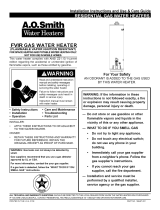
2
TABLE OF CONTENTS
Water Heater Safety .............................................................................................................................................................................. 1
Safe Installation, Use and Service ...................................................................................................................................................... 3
Safety Precautions ............................................................................................................................................................................ 3-4
Typical Installation ............................................................................................................................................................................... 5
Installing your Gas Water Heater ..................................................................................................................................................... 6-8
Important Information About Your Water Heater ...................................................................................................................... 6
Consumer Information ............................................................................................................................................................. 6
Consumer Responsibilities ...................................................................................................................................................... 6
Unpacking the Water Heater ................................................................................................................................................... 6
Location Requirements ............................................................................................................................................................ 7
Site Location ............................................................................................................................................................................ 7
Clearances and Accessibility ................................................................................................................................................... 8
State of California .................................................................................................................................................................... 8
Gas Supply ....................................................................................................................................................................................... 9-10
Gas Requirements .................................................................................................................................................................... 9
Gas Piping ............................................................................................................................................................................... 9
Gas Pressure ........................................................................................................................................................................... 9
Gas Pressure Testing ............................................................................................................................................................... 9
LP Gas Only ........................................................................................................................................................................... 10
Combustion Air and Ventilation ....................................................................................................................................................11-15
Unconfined Space ...................................................................................................................................................................11
Confined Space ......................................................................................................................................................................11
All Air from Inside the Building ............................................................................................................................................... 12
All Air from Outdoors .............................................................................................................................................................. 12
Louvers and Grilles ........................................................................................................................................................... 12-13
Vent Pipe System .................................................................................................................................................................. 13
Draft Hood Installation ...................................................................................................................................................... 13-14
Vent Pipe Size ....................................................................................................................................................................... 14
Vent Connectors .................................................................................................................................................................... 14
Chimney Connection .............................................................................................................................................................. 14
Vertical Exhaust Gas Vent ................................................................................................................................................ 14-15
Water System Piping ..................................................................................................................................................................... 15-18
Piping Installation .............................................................................................................................................................. 15-16
Closed System/Thermal Expansion ....................................................................................................................................... 16
Temperature & Pressure Relief Valve .................................................................................................................................... 17
T&P Relief Valve and Pipe Installation .................................................................................................................................. 17
Combination Space Heating/Potable Water System ........................................................................................................ 17-18
Solar Installation .................................................................................................................................................................... 18
Important Information About this Water Heater ..............................................................................................................................19
Operating Your Water Heater ....................................................................................................................................................... 20-26
Lighting Instructions .......................................................................................................................................................... 20-21
Checking the Draft ................................................................................................................................................................. 22
Burner Flames ....................................................................................................................................................................... 22
Emergency Shutdown ..........................................................................................................
.................................................. 22
Water Temperature Regulation ......................................................................................................................................... 22-23
Operating the Temperature Control System ........................................................................................................................... 23
Operational Conditions ..................................................................................................................................................... 23-24
Draining and Flushing ............................................................................................................................................................. 25
Routine Preventive Maintenance ........................................................................................................................................... 25
Temperature and Pressure Relief Valve ........................................................................................................................... 25-26
Maintenance of Your Water Heater .............................................................................................................................................. 26-29
Replacement Parts ................................................................................................................................................................ 26
Removing the Burner from the Manifold/Burner Assembly ................................................................................................... 26
Replacing the Pilot / Thermopile Assembly ........................................................................................................................... 27
External Inspection & Cleaning of the Base-Ring Filter ........................................................................................................ 28
Cleaning the Combustion Chamber and Flame-arrestor ....................................................................................................... 28
Replacing the Manifold Burner/Assembly ......................................................................................................................... 28-29
Piezoelectric Igniter System .................................................................................................................................................. 29
Testing the Igniter System ..................................................................................................................................................... 29
Removing and Replacing the Gas Control Valve/Thermostat ............................................................................................... 29
FVIR System Operational Checklist ...................................................................................................................................... 30
Troubleshooting Checklist ........................................................................................................................................................... 30-31
Pilot Light Troubleshooting Flowchart ............................................................................................................................................ 32
Status Light and Diagnostic Code Troubleshooting Chart ........................................................................................................ 33-34
Notes .... ............................................................................................................................................................................................... 35
Repair Parts ................................................................................................................................................................................... 36-37
Warranty .......................................................................................................................................................................................... 38-39




















